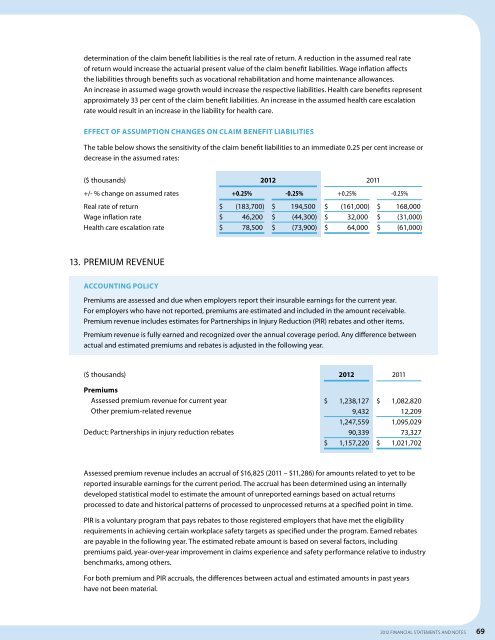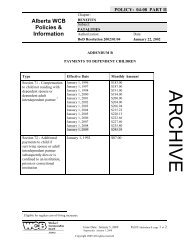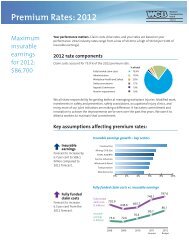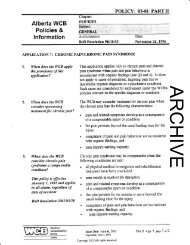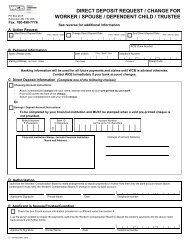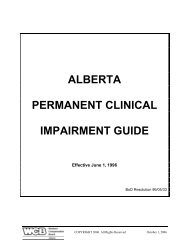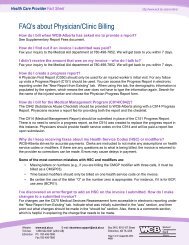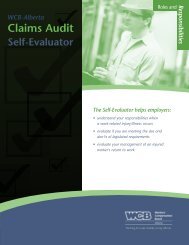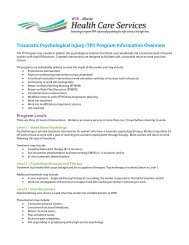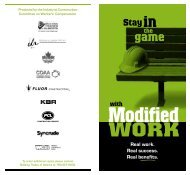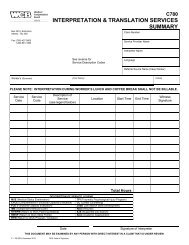2012 Financial Statements - Workers' Compensation Board
2012 Financial Statements - Workers' Compensation Board
2012 Financial Statements - Workers' Compensation Board
Create successful ePaper yourself
Turn your PDF publications into a flip-book with our unique Google optimized e-Paper software.
determination of the claim benefit liabilities is the real rate of return. A reduction in the assumed real rate<br />
of return would increase the actuarial present value of the claim benefit liabilities. Wage inflation affects<br />
the liabilities through benefits such as vocational rehabilitation and home maintenance allowances.<br />
An increase in assumed wage growth would increase the respective liabilities. Health care benefits represent<br />
approximately 33 per cent of the claim benefit liabilities. An increase in the assumed health care escalation<br />
rate would result in an increase in the liability for health care.<br />
Effect of Assumption Changes on Claim Benefit Liabilities<br />
The table below shows the sensitivity of the claim benefit liabilities to an immediate 0.25 per cent increase or<br />
decrease in the assumed rates:<br />
($ thousands) <strong>2012</strong> 2011<br />
+/- % change on assumed rates +0.25% -0.25% +0.25% -0.25%<br />
Real rate of return<br />
Wage inflation rate<br />
Health care escalation rate<br />
$(183,700)<br />
$46,200<br />
$78,500<br />
$194,500<br />
$(44,300)<br />
$(73,900)<br />
$(161,000)<br />
$32,000<br />
$64,000<br />
$168,000<br />
$(31,000)<br />
$(61,000)<br />
13. PREMIUM REVENUE<br />
ACCOUNTING POLICY<br />
Premiums are assessed and due when employers report their insurable earnings for the current year.<br />
For employers who have not reported, premiums are estimated and included in the amount receivable.<br />
Premium revenue includes estimates for Partnerships in Injury Reduction (PIR) rebates and other items.<br />
Premium revenue is fully earned and recognized over the annual coverage period. Any difference between<br />
actual and estimated premiums and rebates is adjusted in the following year.<br />
($ thousands) <strong>2012</strong> 2011<br />
Premiums<br />
Assessed premium revenue for current year<br />
Other premium-related revenue<br />
Deduct: Partnerships in injury reduction rebates<br />
$1,238,127<br />
9,432<br />
1,247,559<br />
90,339<br />
$1,157,220<br />
$1,082,820<br />
12,209<br />
1,095,029<br />
73,327<br />
$ 1,021,702<br />
Assessed premium revenue includes an accrual of $16,825 (2011 – $11,286) for amounts related to yet to be<br />
reported insurable earnings for the current period. The accrual has been determined using an internally<br />
developed statistical model to estimate the amount of unreported earnings based on actual returns<br />
processed to date and historical patterns of processed to unprocessed returns at a specified point in time.<br />
PIR is a voluntary program that pays rebates to those registered employers that have met the eligibility<br />
requirements in achieving certain workplace safety targets as specified under the program. Earned rebates<br />
are payable in the following year. The estimated rebate amount is based on several factors, including<br />
premiums paid, year-over-year improvement in claims experience and safety performance relative to industry<br />
benchmarks, among others.<br />
For both premium and PIR accruals, the differences between actual and estimated amounts in past years<br />
have not been material.<br />
<strong>2012</strong> FINANCIAL STATEMENTS and notes 69


